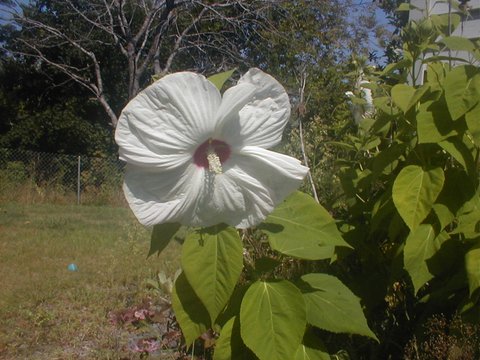GMG FOB Allen Sloane writes with the subject line White, Floppy, and Big:
It was a pleasure to meet and talk with you on Saturday.
Thanks for all the info on poke weeds. My dog doesn’t seem to have any interest in the berries so some day I’ll get around to removing it.
Last night I went to look at it and right next to it is this plant which has decided to blossom. I have seen a couple of other plants in the neighborhood so I don’t know if they are from seed or it is a cultural decision to grow them. Be my guest if you want to answer via your daily post.
Hi Allen,
The gorgeous flower in the photo that you sent is the North American native Hibiscus moscheutos, also known by many common names, including rose mallow, swamp mallow, eastern rosemallow, and crimson-eyed rose mallow. Crimson-eyed rose mallow blooms in shades of pure white to cheery pink and deepest rose red.
To answer your question, the seeds are dispersed by birds, and they are also readily available in nurseries. Locally, Wolf Hill always has a lovely selection. I plant rose mallows widely in my client’s native plants gardens as well as in Arts and Crafts period gardens because they are beautiful, easily tended, and are a terrific source of nectar for ruby-throated hummingbirds. H. moscheutos grow beautifully along marsh edges as well as in gardens. There’s a sweet patch growing at Niles Pond, and I am sure we would see many more if phragmites weren’t supplanting all our marsh wildflowers.
We planted a patch at the HarborWalk, but sadly they were stolen. Next year I am hoping we can replace the lost plants!
The following is an excerpt from an article that I wrote awhile back, titled “Growing Native:”
“…Throughout the American Arts and Crafts movement, and well into the 1930’s, home and garden magazines, among the most influential sources of ideas for the homeowner, espoused the use of native plants in the landscape. Perhaps the most notable was Gustav Stickley’s The Craftsman, which was published for fifteen years, beginning in 1901. Stickley revered the North American white oak (Quercus alba), admiring it for its majestic role in the eastern forest and for its unique strength and figuring of the wood for furniture making. A sense of connectedness to nature is at the heart of the ideals of the Arts and Crafts movement and the popular writing of the era reflects how to create this relationship.
I am reminded of a lovely and memorable cover of Country Living for the September 1905 issue featuring a drift of rose mallows (Hibiscus moscheutos), which resemble and are closely related to hollyhocks (Alcea rosea). Both are members of the Malvaceae or Mallow Family. Hibiscus moscheutos are commonly referred to as crimson-eyed rose mallow and also marsh mallow, because the roots were used to make marshmallows. Rose mallows are a practical and economical native perennial as they reliably return year after year, unlike hollyhocks, although charming and beautiful, are short-lived (with the exception of Alcea rugosa). Rose mallows bloom in shades of pale pink to deeper rosey pink, from July through the first frost. Although found growing in marshy areas along stream and river banks, rose mallows will flourish in the garden when provided with rich moist soil and planted in a sunny location. New growth is slow to emerge in the spring. When cutting back the expired stalks after the first hard frost of autumn, leave a bit of the woody stalk to mark its spot for the following year. The leavesof Hibiscus moscheutos are a host plant for the Gray Hairstreak butterfly and the flowers provide nectar for Ruby-throated hummingbirds.”





Talk about a walk through wonderland – is that a lazy susan in there somewhere? thanks beautiful shots! 🙂 Dave & Kim:-)
LikeLike